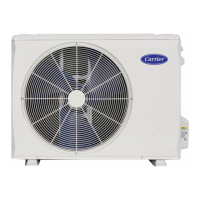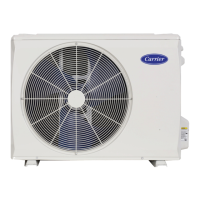38MURA: Installation Instructions
Manufacturer reserves the right to change, at any time, specifications and designs without notice and without obligations.
11
IMPORTANT: The suction line must be insulated. Use
refrigeration grade tubing ONLY. No other type of tubing may
be used. Use of other types of tubing will void the
manufacturer's warranty.
• The minimum refrigerant line length between the indoor and outdoor
unit is 10 ft. (3m).
• All outdoor units have an electronic expansion valve to manage the
refrigerant flow of the fan coil connected.
• Do not open the service valves or remove the protective caps from the
tubing ends until all connections are made.
• Bend the tubing with bending tools to avoid kinks and flat spots.
• Keep the tubing free of dirt, sand, moisture, and other contaminants to
avoid damaging the refrigerant system.
• Avoid sags in the suction line to prevent the formation of oil traps.
• Insulate the suction line with a minimum 3/8-in. (10 mm) wall thermal
pipe insulation. Inserting the tubing into the insulation before making
the connections will save time and improve installation quality.
Use the following steps to connect the refrigerant piping:
1. Run the interconnecting piping from the outdoor unit to the indoor unit.
2. Connect the refrigerant piping and drain line outside the indoor unit.
Complete the pipe insulation at the flare connection then fasten the
piping and wiring to the wall as required. Completely seal the hole in
the wall.
3. Cut tubing to the correct length.
When preparing refrigerant pipes, take extra care to cut and flare
them properly. This ensures efficient operation and minimizes the
need for future maintenance.
a. Measure the distance between the indoor and outdoor units.
b. Using a pipe cutter, cut the pipe a little longer than the measured
distance.
c. Make sure the pipe is cut at a perfect 90° angle.
Fig. 12 —Pipe Cutting
4. Remove the Burrs
Burrs can affect the air-tight seal of the refrigerant piping connection.
Therefore, they must be completely removed. To remove:
a. Hold the pipe at a downward angle to prevent burrs from
falling into the pipe.
b. Using a reamer or deburring tool, remove all burrs from the cut
section of the pipe.
Fig. 13 — Deburring Tool
5. Flare the Pipe Ends
Proper flaring is essential to achieving an airtight seal.
a. After removing the burrs from the cut pipe, seal the ends with PVC
tape to prevent foreign materials from entering the pipe.
b. Sheath the pipe with insulating material.
c. Place factory flare nut on pipe facing the proper direction. Make
sure they are facing the right direction. Once the ends are flared, it
is impossible to put them on or change their direction.
Fig. 14 — Copper pipe and flare nut
d. Remove the PVC tape from ends of pipe when ready to perform the
flaring work.
e. Clamp the flare block on the end of the pipe. The end of the pipe
must extend beyond the flare form.
f. Place the flaring tool onto the form.
All field piping must be completed by a licensed technician and
must comply with the local and national regulations.
When the system is installed in a small room, measures must be
taken to prevent the refrigerant concentration in the room from
exceeding the safety limit in the event of refrigerant leakage. If the
refrigerant leaks and its concentration exceeds its proper limit,
hazards due to lack of oxygen may result.
When installing the refrigeration system, ensure that air, dust,
moisture or foreign substances do not enter the refrigerant circuit.
Contamination in the system may cause poor operating capacity,
high pressure in the refrigeration cycle, explosion or injury.
Ventilate the area immediately if there is refrigerant leakage
during the installation.
Leaked refrigerant gas is hazardous. Ensure there is no refrigerant
leakage after completing the installation work.
WARNING
DO NOT install the connecting pipe until both the indoor and
outdoor units have been installed.
Insulate the suction line to prevent condensation.
CAUTION
DO NOT DEFORM PIPE WHILE CUTTING
Be extra careful not to damage, dent, or deform the pipe while
cutting. This will drastically reduce the heating efficiency of the unit.
CAUTION

